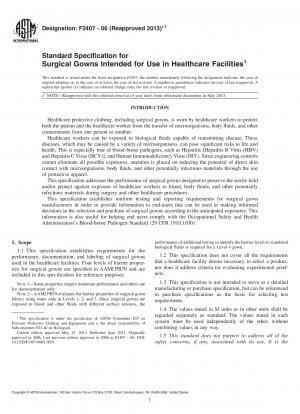ASTM F2407-06(2013)e1
Standard Specification for Surgical Gowns Intended for Use in Healthcare Facilities
- Standard No.
- ASTM F2407-06(2013)e1
- Release Date
- 2006
- Published By
- American Society for Testing and Materials (ASTM)
- Status
- Replace By
- ASTM F2407-20
- Latest
- ASTM F2407/F2407M-23a
- Scope
4.1 This specification provides requirements for surgical gowns used for protection of healthcare workers where the potential for exposure to blood, body fluids, and other potentially infectious materials exists. The specification requires barrier testing based on the system of classifying gowns established in AAMI8201;PB70 and sets general safety requirements for surgical gowns based on biocompatibility, sterility assurance, and flame spread. Documentation and reporting requirements are set for important physical properties including tensile strength, tear resistance, seam strength, linting resistance, evaporative resistance testing, and water vapor transmission rate.
4.2 This specification does not address protective clothing used for non-surgical applications, such as isolation gowns or decontamination gowns; protective clothing for the hands, such as surgical gloves, patient examination gloves, or other medical gloves; protective clothing for the head, such as goggles or face shields, surgical caps or hoods, surgical masks, or respirators; protective clothing for the feet, such as operating room shoes, shoe covers, or surgical boots; or other types of protective clothing and equipment worn by health care providers.
4.3 Surgical gowns are either multiple-use or single-use products as designated by the manufacturer. This specification is intended to provide the basis for manufacturer claims for surgical gown performance and efficacy. For multiple-use gowns, this specification takes into account the anticipated care and maintenance of these products, by examining test requirements for surgical gown materials both before and after the maximum expected number of cycles for laundering and sterilization.
4.4 Additional information on the processing of multiple-use surgical gowns is provided in AAMI8201;ST65.
4.5 While surgical gowns are classified for barrier performance as specified in AAMI8201;PB70, this specification establishes certain other physical performance and documentation requirements for surgical gowns and their materials. Design requirements and recommendations are also provided for surgical gowns.
4.6 Additional information for the testing, selection, and use of surgical gowns is provided in AAMI8201;TIR11.
1.1 This specification establishes requirements for the performance, documentation, and labeling of surgical gowns used in the healthcare facilities. Four levels of barrier properties for surgical gowns are specified in AAMI8201;PB70 and are included in this speci......
ASTM F2407-06(2013)e1 Referenced Document
- ASTM D1683 Standard Test Method for Failure in Sewn Seams of Woven Apparel Fabrics*, 2024-04-20 Update
- ASTM D1776 Standard Practice for Conditioning and Testing Textiles
- ASTM D5034 Standard Test Method for Breaking Strength and Elongation of Textile Fabrics (Grab Test)
- ASTM D5587 Standard Test Method for Tearing Strength of Fabrics by Trapezoid Procedure
- ASTM D5733 Standard Test Method for Tearing Strength of Nonwoven Fabrics by the Trapezoid Procedure
- ASTM D6701 Standard Test Method for Determining Water Vapor Transmission Rates Through Nonwoven and Plastic Barriers
- ASTM D751 Standard Test Methods for Coated Fabrics
- ASTM F1494 Standard Terminology Relating to Protective Clothing
- ASTM F1671 Standard Test Method for Resistance of Materials Used in Protective Clothing to Penetration by Blood-Borne Pathogens Using Phi-X174 Bacteriophage Penetration as a Test System
- ASTM F1868 Standard Test Method for Thermal and Evaporative Resistance of Clothing Materials Using a Sweating Hot Plate
- ISO 11134 Sterilization of health care products; requirements for validation and routine control; industrial moist heat sterilization
- ISO 11135 Sterilization of health-care products — Ethylene oxide — Requirements for the development, validation and routine control of a sterilization process for medical devices AMENDMENT 1: Revision of Annex E, Single batch release
- ISO 11137 Sterilization of health care products - Requirements for validation and routine control - Radiation sterilization; Technical Corrigendum 1
- ISO 13683 Sterilization of health care products - Requirements for validation and routine control of moist heat sterilization in health care facilities
- ISO 2859-1 Sampling procedures for inspection by attributes - Part 1: Sampling schemes indexed by acceptance quality limit (AQL) for lot-by-lot inspection; Technical Corrigendum 1
- ISO 3951 Sampling procedures and charts for inspection by variables for percent nonconforming
- ISO 9073 Textiles - Test methods for nonwovens - Part 9: Determination of drapability including drape coefficient
ASTM F2407-06(2013)e1 history
- 2023 ASTM F2407/F2407M-23a Standard Specification for Surgical Gowns Intended for Use in Healthcare Facilities
- 2023 ASTM F2407/F2407M-23 Standard Specification for Surgical Gowns Intended for Use in Healthcare Facilities
- 2022 ASTM F2407/F2407M-22a Standard Specification for Surgical Gowns Intended for Use in Healthcare Facilities
- 2022 ASTM F2407/F2407M-22 Standard Specification for Surgical Gowns Intended for Use in Healthcare Facilities
- 2020 ASTM F2407-20 Standard Specification for Surgical Gowns Intended for Use in Healthcare Facilities
- 2006 ASTM F2407-06(2013)e1 Standard Specification for Surgical Gowns Intended for Use in Healthcare Facilities
- 2006 ASTM F2407-06 Standard Specification for Surgical Gowns Intended for Use in Healthcare Facilities

Copyright ©2024 All Rights Reserved